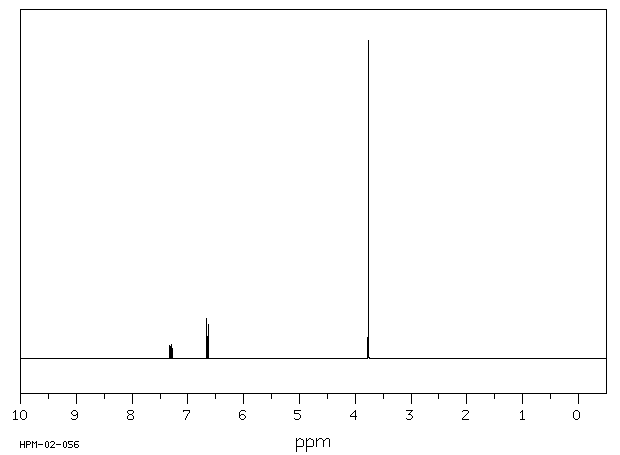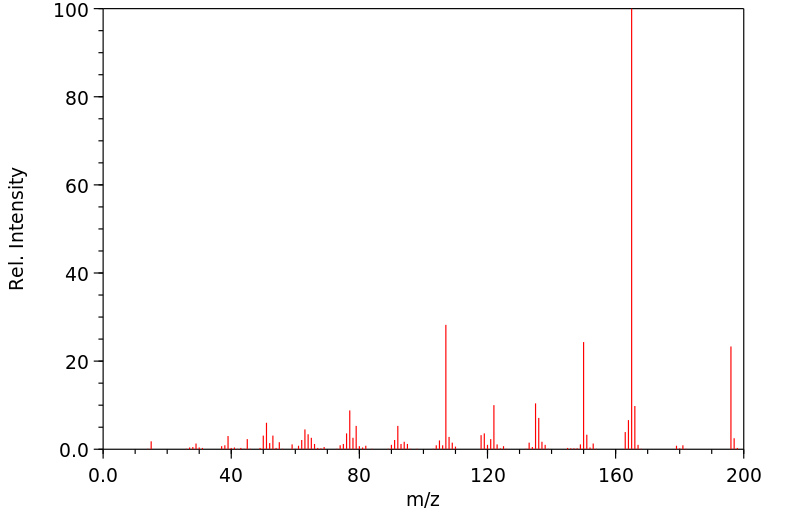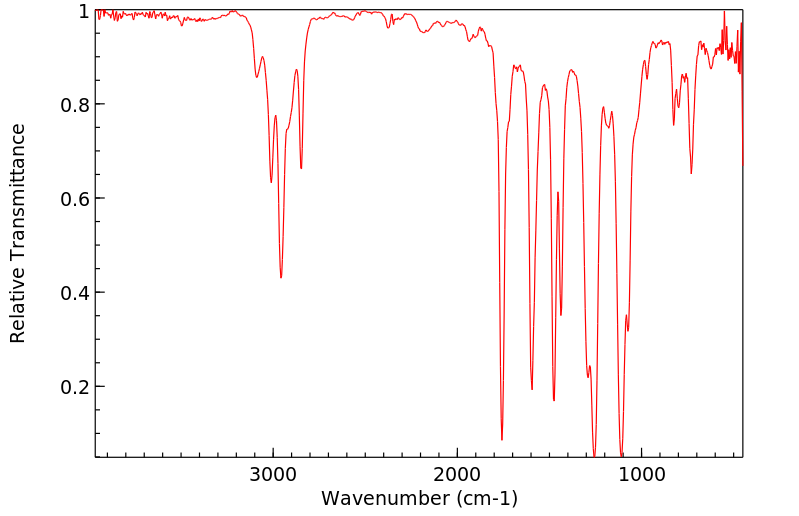2,6-二甲氧基苯甲酸甲酯 | 2065-27-2
中文名称
2,6-二甲氧基苯甲酸甲酯
中文别名
甲基-2,6-二甲氧基苯甲酸酯
英文名称
methyl 2,6-dimethoxybenzoate
英文别名
2,6-Dimethoxy-benzoesaeure-methylester;2,6-dimethoxybenzoic acid methyl ester;Methyl-2.6-dimethoxybenzoat
CAS
2065-27-2
化学式
C10H12O4
mdl
MFCD00075861
分子量
196.203
InChiKey
XLXVNKPXOIYLLE-UHFFFAOYSA-N
BEILSTEIN
——
EINECS
——
-
物化性质
-
计算性质
-
ADMET
-
安全信息
-
SDS
-
制备方法与用途
-
上下游信息
-
文献信息
-
表征谱图
-
同类化合物
-
相关功能分类
-
相关结构分类
物化性质
-
熔点:87-90 °C (lit.)
-
沸点:160-172 °C(Press: 14 Torr)
-
密度:1.119±0.06 g/cm3(Predicted)
-
保留指数:1536.3
-
稳定性/保质期:
如果按照规格使用和储存,一般不会分解,没有已知危险反应。应避免接触氧化物。
计算性质
-
辛醇/水分配系数(LogP):1
-
重原子数:14
-
可旋转键数:4
-
环数:1.0
-
sp3杂化的碳原子比例:0.3
-
拓扑面积:44.8
-
氢给体数:0
-
氢受体数:4
安全信息
-
WGK Germany:3
-
海关编码:2918990090
-
危险性防范说明:P261,P280,P301+P312,P302+P352,P305+P351+P338
-
危险性描述:H302,H315,H319,H335
-
储存条件:请将贮藏器密封保存,在阴凉、干燥处存放,并确保工作环境有良好通风或排气设施。
SDS
SECTION 1: Identification of the substance/mixture and of the company/undertaking
Product identifiers
Product name : Methyl 2,6-dimethoxybenzoate
REACH No. : A registration number is not available for this substance as the substance
or its uses are exempted from registration, the annual tonnage does not
require a registration or the registration is envisaged for a later
registration deadline.
CAS-No. : 2065-27-2
Relevant identified uses of the substance or mixture and uses advised against
Identified uses : Laboratory chemicals, Manufacture of substances
SECTION 2: Hazards identification
Classification of the substance or mixture
Not a hazardous substance or mixture according to Regulation (EC) No. 1272/2008.
This substance is not classified as dangerous according to Directive 67/548/EEC.
Label elements
The product does not need to be labelled in accordance with EC directives or respective national laws.
Other hazards - none
SECTION 3: Composition/information on ingredients
Substances
Formula : C10H12O4 C10H12O4
Molecular Weight : 196,20 g/mol
: 196,20 g/mol
CAS-No. : 2065-27-2
No components need to be disclosed according to the applicable regulations.
SECTION 4: First aid measures
Description of first aid measures
If inhaled
If breathed in, move person into fresh air. If not breathing, give artificial respiration.
In case of skin contact
Wash off with soap and plenty of water.
In case of eye contact
Flush eyes with water as a precaution.
If swallowed
Never give anything by mouth to an unconscious person. Rinse mouth with water.
Most important symptoms and effects, both acute and delayed
The most important known symptoms and effects are described in the labelling (see section 2.2) and/or in
section 11
Indication of any immediate medical attention and special treatment needed
no data available
SECTION 5: Firefighting measures
Extinguishing media
Suitable extinguishing media
Use water spray, alcohol-resistant foam, dry chemical or carbon dioxide.
Special hazards arising from the substance or mixture
Carbon oxides
Advice for firefighters
Wear self contained breathing apparatus for fire fighting if necessary.
Further information
no data available
SECTION 6: Accidental release measures
Personal precautions, protective equipment and emergency procedures
Avoid dust formation. Avoid breathing vapours, mist or gas.
For personal protection see section 8.
Environmental precautions
Do not let product enter drains.
Methods and materials for containment and cleaning up
Sweep up and shovel. Keep in suitable, closed containers for disposal.
Reference to other sections
For disposal see section 13.
SECTION 7: Handling and storage
Precautions for safe handling
Provide appropriate exhaust ventilation at places where dust is formed.Normal measures for preventive fire
protection.
For precautions see section 2.2.
Conditions for safe storage, including any incompatibilities
Keep container tightly closed in a dry and well-ventilated place. Store in cool place.
Specific end use(s)
A part from the uses mentioned in section 1.2 no other specific uses are stipulated
SECTION 8: Exposure controls/personal protection
Control parameters
Components with workplace control parameters
Exposure controls
Appropriate engineering controls
General industrial hygiene practice.
Personal protective equipment
Eye/face protection
Use equipment for eye protection tested and approved under appropriate government standards
such as NIOSH (US) or EN 166(EU).
Skin protection
Handle with gloves. Gloves must be inspected prior to use. Use proper glove removal technique
(without touching glove's outer surface) to avoid skin contact with this product. Dispose of
contaminated gloves after use in accordance with applicable laws and good laboratory practices.
Wash and dry hands.
The selected protective gloves have to satisfy the specifications of EU Directive 89/686/EEC and
the standard EN 374 derived from it.
Body Protection
Choose body protection in relation to its type, to the concentration and amount of dangerous
substances, and to the specific work-place., The type of protective equipment must be selected
according to the concentration and amount of the dangerous substance at the specific workplace.
Respiratory protection
Respiratory protection is not required. Where protection from nuisance levels of dusts are desired,
use type N95 (US) or type P1 (EN 143) dust masks. Use respirators and components tested and
approved under appropriate government standards such as NIOSH (US) or CEN (EU).
Control of environmental exposure
Do not let product enter drains.
SECTION 9: Physical and chemical properties
Information on basic physical and chemical properties
a) Appearance Form: solid
b) Odour no data available
c) Odour Threshold no data available
d) pH no data available
e) Melting point/freezing Melting point/range: 87 - 90 °C
point
f) Initial boiling point and no data available
boiling range
g) Flash point no data available
h) Evapouration rate no data available
i) Flammability (solid, gas) no data available
j) Upper/lower no data available
flammability or
explosive limits
k) Vapour pressure no data available
l) Vapour density no data available
m) Relative density no data available
n) Water solubility no data available
o) Partition coefficient: n- no data available
octanol/water
p) Auto-ignition no data available
temperature
q) Decomposition no data available
temperature
r) Viscosity no data available
s) Explosive properties no data available
t) Oxidizing properties no data available
Other safety information
no data available
SECTION 10: Stability and reactivity
Reactivity
no data available
Chemical stability
Stable under recommended storage conditions.
Possibility of hazardous reactions
no data available
Conditions to avoid
no data available
Incompatible materials
Strong oxidizing agents
Hazardous decomposition products
Other decomposition products - no data available
In the event of fire: see section 5
SECTION 11: Toxicological information
Information on toxicological effects
Acute toxicity
no data available
Skin corrosion/irritation
no data available
Serious eye damage/eye irritation
no data available
Respiratory or skin sensitisation
no data available
Germ cell mutagenicity
no data available
Carcinogenicity
IARC: No component of this product present at levels greater than or equal to 0.1% is identified as
probable, possible or confirmed human carcinogen by IARC.
Reproductive toxicity
no data available
Specific target organ toxicity - single exposure
no data available
Specific target organ toxicity - repeated exposure
no data available
Aspiration hazard
no data available
Additional Information
RTECS: Not available
To the best of our knowledge, the chemical, physical, and toxicological properties have not been
thoroughly investigated.
SECTION 12: Ecological information
Toxicity
no data available
Persistence and degradability
no data available
Bioaccumulative potential
no data available
Mobility in soil
no data available
Results of PBT and vPvB assessment
PBT/vPvB assessment not available as chemical safety assessment not required/not conducted
Other adverse effects
no data available
SECTION 13: Disposal considerations
Waste treatment methods
Product
Offer surplus and non-recyclable solutions to a licensed disposal company.
Contaminated packaging
Dispose of as unused product.
SECTION 14: Transport information
UN number
ADR/RID: - IMDG: - IATA: -
UN proper shipping name
ADR/RID: Not dangerous goods
IMDG: Not dangerous goods
IATA: Not dangerous goods
Transport hazard class(es)
ADR/RID: - IMDG: - IATA: -
Packaging group
ADR/RID: - IMDG: - IATA: -
Environmental hazards
ADR/RID: no IMDG Marine pollutant: no IATA: no
Special precautions for user
no data available
SECTION 15: Regulatory information
This safety datasheet complies with the requirements of Regulation (EC) No. 1907/2006.
Safety, health and environmental regulations/legislation specific for the substance or mixture
no data available
Chemical Safety Assessment
For this product a chemical safety assessment was not carried out
SECTION 16: Other information
Further information
Copyright 2013 Co. LLC. License granted to make unlimited paper copies for internal use
only.
The above information is believed to be correct but does not purport to be all inclusive and shall be
used only as a guide. The information in this document is based on the present state of our knowledge
and is applicable to the product with regard to appropriate safety precautions. It does not represent any
guarantee of the properties of the product. Corporation and its Affiliates shall not be held
liable for any damage resulting from handling or from contact with the above product. See
and/or the reverse side of invoice or packing slip for additional terms and conditions of sale.
上下游信息
-
上游原料
中文名称 英文名称 CAS号 化学式 分子量 2,6-二甲氧基苯甲酸 2-6-dimethoxybenzoic acid 1466-76-8 C9H10O4 182.176 6-甲氧基水杨酸 2-hydroxy-6-methoxybenzoic acid 3147-64-6 C8H8O4 168.149 2,6-二羟基苯甲酸甲酯 methyl 2,6-dihydroxybenzoate 2150-45-0 C8H8O4 168.149 2,6-二羟基苯甲酸 2,6-Dihydroxybenzoic acid 303-07-1 C7H6O4 154.122 -
下游产品
中文名称 英文名称 CAS号 化学式 分子量 甲基2-羟基-6-甲氧基苯甲酸酯 methyl 6-methoxysalicylate 22833-69-8 C9H10O4 182.176 —— methoxy-3 salycilate d'ethyl 35030-99-0 C10H12O4 196.203 2-甲氧基苯甲酸甲酯 2-methoxybenzoic acid methyl ester 606-45-1 C9H10O3 166.177 6-甲氧基水杨酸 2-hydroxy-6-methoxybenzoic acid 3147-64-6 C8H8O4 168.149 3-溴-2,6-二甲氧基苯甲酸甲酯 3-Brom-2,6-dimethoxy-benzoesaeure-methylester 65977-12-0 C10H11BrO4 275.099 (2,6-二甲氧基苯基)甲醇 2,6-dimethoxybenzyl alcohol 16700-55-3 C9H12O3 168.192 2,6-二甲氧基苯甲醛 2,6-dimethoxybenzaldehyde 3392-97-0 C9H10O3 166.177
反应信息
-
作为反应物:描述:2,6-二甲氧基苯甲酸甲酯 在 bis(1,5-cyclooctadiene)nickel (0) 、 1,1,3,3-四甲基二硅氧烷 、 potassium tert-butylate 、 1,3-bis(cyclohexyl)imidazolium tetrafluoroborate 、 三环己基膦 作用下, 以 甲苯 为溶剂, 反应 18.0h, 生成 2-甲基苯甲醚参考文献:名称:通过镍催化完全还原酯类摘要:我们报告了将未活化的芳基酯直接还原为其相应的甲苯基衍生物的一步程序。这是通过有机硅烷介导的酯氢化硅烷化反应和随后的 Ni/NHC 催化氢解来实现的。由此产生的条件为通常需要使用危险金属氢化物的这种转化的多步骤程序提供了一种直接有效的替代方法。展示了在合成含 -CD3 的产品、生物活性分子的衍生化以及在其他 CO 键存在下进行化学选择性还原中的应用。DOI:10.1021/jacs.0c02405
-
作为产物:描述:参考文献:名称:Mauthner, Journal fur praktische Chemie (Leipzig 1954), 1929, vol. <2> 121, p. 262摘要:DOI:
文献信息
-
Condensed-Phase, Halogen-Bonded CF<sub>3</sub>I and C<sub>2</sub>F<sub>5</sub>I Adducts for Perfluoroalkylation Reactions作者:Filippo Sladojevich、Eric McNeill、Jonas Börgel、Shao-Liang Zheng、Tobias RitterDOI:10.1002/anie.201410954日期:2015.3.16family of practical, liquid trifluoromethylation and pentafluoroethylation reagents is described. We show how halogen bonding can be used to obtain easily handled liquid reagents from gaseous CF3I and CF3CF2I. The synthetic utility of the new reagents is exemplified by a novel direct arene trifluoromethylation reaction as well as adaptations of other perfluoroalkylation reactions.
-
Dimethylmalonyltrialkylphosphoranes: New General Reagents for Esterification Reactions Allowing Controlled Inversion or Retention of Configuration on Chiral Alcohols作者:James McNulty、Alfredo Capretta、Vladimir Laritchev、Jeff Dyck、Al J. RobertsonDOI:10.1021/jo026639y日期:2003.2.1through reaction of a trialkylphosphine with 2-chlorodimethylmalonate in the presence of triethylamine. These new reagents promote the condensation reaction of carboxylic acids with alcohols to provide esters along with trialkylphosphine oxide and dimethylmalonate. The condensation reaction of chiral secondary alcohols can be controlled to give either high levels of inversion or retention through a
-
A Metal‐Free Direct Arene C−H Amination作者:Tao Wang、Marvin Hoffmann、Andreas Dreuw、Edina Hasagić、Chao Hu、Philipp M. Stein、Sina Witzel、Hongwei Shi、Yangyang Yang、Matthias Rudolph、Fabian Stuck、Frank Rominger、Marion Kerscher、Peter Comba、A. Stephen K. HashmiDOI:10.1002/adsc.202100236日期:2021.6.8The synthesis of aryl amines via the formation of a C−N bond is an essential tool for the preparation of functional materials, active pharmaceutical ingredients and bioactive products. Usually, this chemical connection is only possible by transition metal-catalyzed reactions, photochemistry or electrochemistry. Here, we report a metal-free arene C−H amination using hydroxylamine derivatives under benign
-
Nitrogen enriched mesoporous organic polymer anchored copper(<scp>ii</scp>) material: an efficient and reusable catalyst for the synthesis of esters and amides from aromatic systems作者:Rostam Ali Molla、Md. Asif Iqubal、Kajari Ghosh、Kamaluddin Kamaluddin、Sk. Manirul IslamDOI:10.1039/c4dt03838j日期:——
New mesoporous polymer anchored copper acetate (Cu-mPMF) has been synthesized and well characterized. The catalytic performance of this complex has been tested for the synthesis of esters and amides.
新的介孔聚合物锚定醋酸铜(Cu-mPMF)已经合成并得到了良好的表征。该复合物的催化性能已经用于酯和酰胺的合成测试。 -
[EN] FLUOROALKYLATION REAGENTS AND USES THEREOF<br/>[FR] RÉACTIFS DE FLUOROALKYLATION ET LEURS UTILISATIONS申请人:HARVARD COLLEGE公开号:WO2015168368A1公开(公告)日:2015-11-05Provided herein are halogen-bonded complexes of Formula (I), wherein is a halogen bond; R1 is unsubstituted C1-3 fluoroalkyl; D is N(R2)3, ((R2)2N)2C=NR2, 0=S(R2)2, substituted or unsubstituted heterocyclyl, or substituted or unsubstituted heteroaryl, and wherein R2 and y are as defined herein. D----(I−−R1)y (I) Further provided are methods of preparing compounds of Formula (I), compositions, reagents, and kits comprising a compound of Formula (I), and methods for fluoroalkylating an organic compound using a compound of Formula (I).本文提供了公式(I)的卤素键合物,其中卤素键;R1是未取代的C1-3氟烷基;D是N(R2)3,((R2)2N)2C=NR2,0=S(R2)2,取代或未取代的杂环烷基,或取代或未取代的杂芳基,其中R2和y如本文所定义。D----(I−−R1)y(I)此外,还提供了制备公式(I)化合物的方法,包含公式(I)化合物的组合物、试剂和试剂盒,以及使用公式(I)化合物对有机化合物进行氟烷基化的方法。
表征谱图
-
氢谱1HNMR
-
质谱MS
-
碳谱13CNMR
-
红外IR
-
拉曼Raman
-
峰位数据
-
峰位匹配
-
表征信息
同类化合物
(βS)-β-氨基-4-(4-羟基苯氧基)-3,5-二碘苯甲丙醇
(S,S)-邻甲苯基-DIPAMP
(S)-(-)-7'-〔4(S)-(苄基)恶唑-2-基]-7-二(3,5-二-叔丁基苯基)膦基-2,2',3,3'-四氢-1,1-螺二氢茚
(S)-盐酸沙丁胺醇
(S)-3-(叔丁基)-4-(2,6-二甲氧基苯基)-2,3-二氢苯并[d][1,3]氧磷杂环戊二烯
(S)-2,2'-双[双(3,5-三氟甲基苯基)膦基]-4,4',6,6'-四甲氧基联苯
(S)-1-[3,5-双(三氟甲基)苯基]-3-[1-(二甲基氨基)-3-甲基丁烷-2-基]硫脲
(R)富马酸托特罗定
(R)-(-)-盐酸尼古地平
(R)-(-)-4,12-双(二苯基膦基)[2.2]对环芳烷(1,5环辛二烯)铑(I)四氟硼酸盐
(R)-(+)-7-双(3,5-二叔丁基苯基)膦基7''-[((6-甲基吡啶-2-基甲基)氨基]-2,2'',3,3''-四氢-1,1''-螺双茚满
(R)-(+)-7-双(3,5-二叔丁基苯基)膦基7''-[(4-叔丁基吡啶-2-基甲基)氨基]-2,2'',3,3''-四氢-1,1''-螺双茚满
(R)-(+)-7-双(3,5-二叔丁基苯基)膦基7''-[(3-甲基吡啶-2-基甲基)氨基]-2,2'',3,3''-四氢-1,1''-螺双茚满
(R)-(+)-4,7-双(3,5-二-叔丁基苯基)膦基-7“-[(吡啶-2-基甲基)氨基]-2,2”,3,3'-四氢1,1'-螺二茚满
(R)-3-(叔丁基)-4-(2,6-二苯氧基苯基)-2,3-二氢苯并[d][1,3]氧杂磷杂环戊烯
(R)-2-[((二苯基膦基)甲基]吡咯烷
(R)-1-[3,5-双(三氟甲基)苯基]-3-[1-(二甲基氨基)-3-甲基丁烷-2-基]硫脲
(N-(4-甲氧基苯基)-N-甲基-3-(1-哌啶基)丙-2-烯酰胺)
(5-溴-2-羟基苯基)-4-氯苯甲酮
(5-溴-2-氯苯基)(4-羟基苯基)甲酮
(5-氧代-3-苯基-2,5-二氢-1,2,3,4-oxatriazol-3-鎓)
(4S,5R)-4-甲基-5-苯基-1,2,3-氧代噻唑烷-2,2-二氧化物-3-羧酸叔丁酯
(4S,4''S)-2,2''-亚环戊基双[4,5-二氢-4-(苯甲基)恶唑]
(4-溴苯基)-[2-氟-4-[6-[甲基(丙-2-烯基)氨基]己氧基]苯基]甲酮
(4-丁氧基苯甲基)三苯基溴化磷
(3aR,8aR)-(-)-4,4,8,8-四(3,5-二甲基苯基)四氢-2,2-二甲基-6-苯基-1,3-二氧戊环[4,5-e]二恶唑磷
(3aR,6aS)-5-氧代六氢环戊基[c]吡咯-2(1H)-羧酸酯
(2Z)-3-[[(4-氯苯基)氨基]-2-氰基丙烯酸乙酯
(2S,3S,5S)-5-(叔丁氧基甲酰氨基)-2-(N-5-噻唑基-甲氧羰基)氨基-1,6-二苯基-3-羟基己烷
(2S,2''S,3S,3''S)-3,3''-二叔丁基-4,4''-双(2,6-二甲氧基苯基)-2,2'',3,3''-四氢-2,2''-联苯并[d][1,3]氧杂磷杂戊环
(2S)-(-)-2-{[[[[3,5-双(氟代甲基)苯基]氨基]硫代甲基]氨基}-N-(二苯基甲基)-N,3,3-三甲基丁酰胺
(2S)-2-[[[[[((1S,2S)-2-氨基环己基]氨基]硫代甲基]氨基]-N-(二苯甲基)-N,3,3-三甲基丁酰胺
(2S)-2-[[[[[[((1R,2R)-2-氨基环己基]氨基]硫代甲基]氨基]-N-(二苯甲基)-N,3,3-三甲基丁酰胺
(2-硝基苯基)磷酸三酰胺
(2,6-二氯苯基)乙酰氯
(2,3-二甲氧基-5-甲基苯基)硼酸
(1S,2S,3S,5S)-5-叠氮基-3-(苯基甲氧基)-2-[(苯基甲氧基)甲基]环戊醇
(1S,2S,3R,5R)-2-(苄氧基)甲基-6-氧杂双环[3.1.0]己-3-醇
(1-(4-氟苯基)环丙基)甲胺盐酸盐
(1-(3-溴苯基)环丁基)甲胺盐酸盐
(1-(2-氯苯基)环丁基)甲胺盐酸盐
(1-(2-氟苯基)环丙基)甲胺盐酸盐
(1-(2,6-二氟苯基)环丙基)甲胺盐酸盐
(-)-去甲基西布曲明
龙蒿油
龙胆酸钠
龙胆酸叔丁酯
龙胆酸
龙胆紫-d6
龙胆紫









